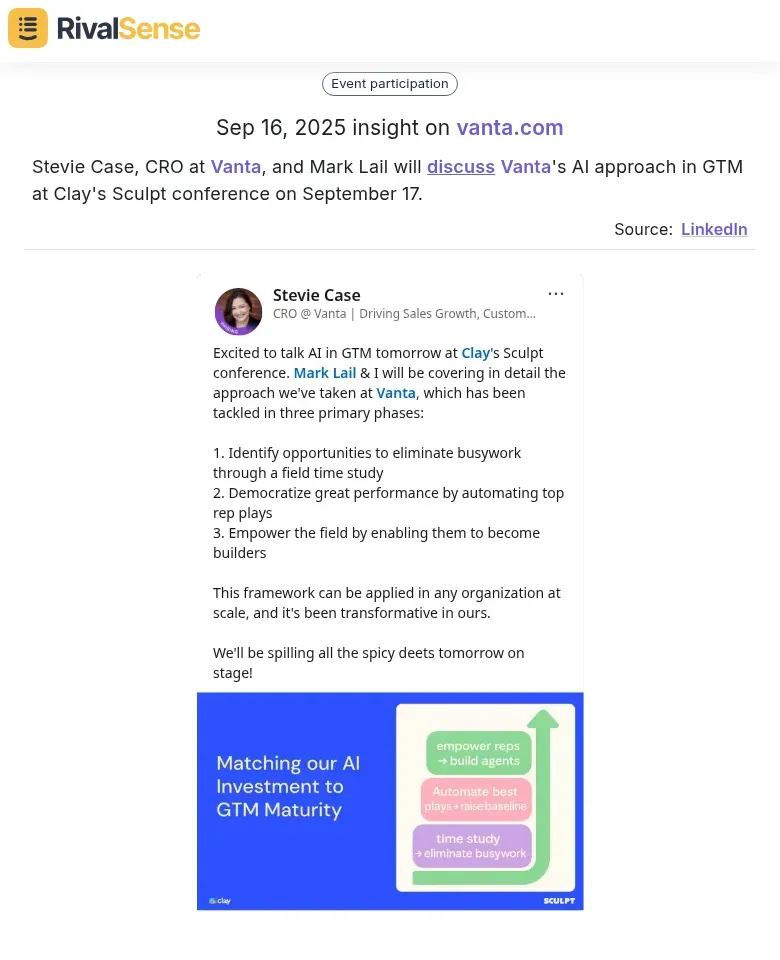How Vanta's AI GTM Strategy Reveals Critical Competitor Insights

When key executives like Stevie Case (CRO) and Mark Lail from Vanta present at industry conferences, it provides invaluable intelligence about their strategic direction. Their scheduled discussion on Vanta's AI approach in Go-To-Market (GTM) at Clay's Sculpt conference offers competitors and industry observers crucial insights into emerging trends and competitive positioning.
🔍 Why Conference Presentations Matter in Competitor Analysis
Executive presentations at major industry events often reveal:
- Strategic priorities and investment areas
- New technology implementations before public announcements
- Partnership directions and ecosystem developments
- Market positioning against competing solutions
💡 Actionable Competitor Tracking Tips
Monitor Executive Appearances:
- Track speaking engagements of C-level executives from competitors
- Note the topics and themes they emphasize
- Record any demoes or case studies presented
Analyze Content Depth:
- Are they discussing proven implementations or future visions?
- What specific AI capabilities are they highlighting?
- How does this align with their recent product updates?
Cross-Reference with Other Data Points:
- Combine conference insights with recent hiring patterns
- Compare with patent filings and technical publications
- Analyze against customer case studies and testimonials
📊 Competitor Intelligence Framework
| Intelligence Type | What to Look For | Why It Matters |
|---|---|---|
| Technology Direction | AI/ML capabilities, integration approaches | Future competitive advantages |
| Market Positioning | Target segments, value proposition changes | Strategic alignment opportunities |
| Partnership Signals | New ecosystem relationships | Partnership and competitive threats |
| Customer Evidence | Case studies, implementation examples | Validation of market acceptance |
🚀 Immediate Action Steps
- Register for the session (if still available) or find recorded content
- Document specific AI capabilities mentioned and their GTM applications
- Compare with your own AI roadmap and identify gaps/opportunities
- Share insights with product and sales teams for competitive positioning
- Update competitive battle cards with new intelligence
📈 Turning Insights into Strategy
Conference intelligence becomes valuable when you:
- Connect dots between different data points (presentations + hiring + product updates)
- Time your competitive responses based on their announcement cycles
- Identify white spaces where competitors aren't focusing
- Anticipate market shifts before they become mainstream
Staying ahead requires not just collecting information but synthesizing it into actionable intelligence. Tools like RivalSense automate the monitoring of competitor activities across websites, social media, and various registries, delivering regular reports that help you stay informed without constant manual tracking.
Ready to streamline your competitor intelligence? Try RivalSense for free and get your first comprehensive competitor report today, helping you track product launches, pricing changes, partnerships, and executive movements across your competitive landscape.
📚 Read more
👉 Unlocking Competitor Social Media Advantages: A Strategic Guide for Business Leaders
👉 How Early Detection of Mapon's Route Planning Expansion Saved 15% Market Share
👉 Data-Driven Website Insights: Track Competitors to Secure Key Account Renewals
👉 7 SaaS Key Account Assessment Mistakes to Avoid (And How Competitive Intelligence Can Help)
